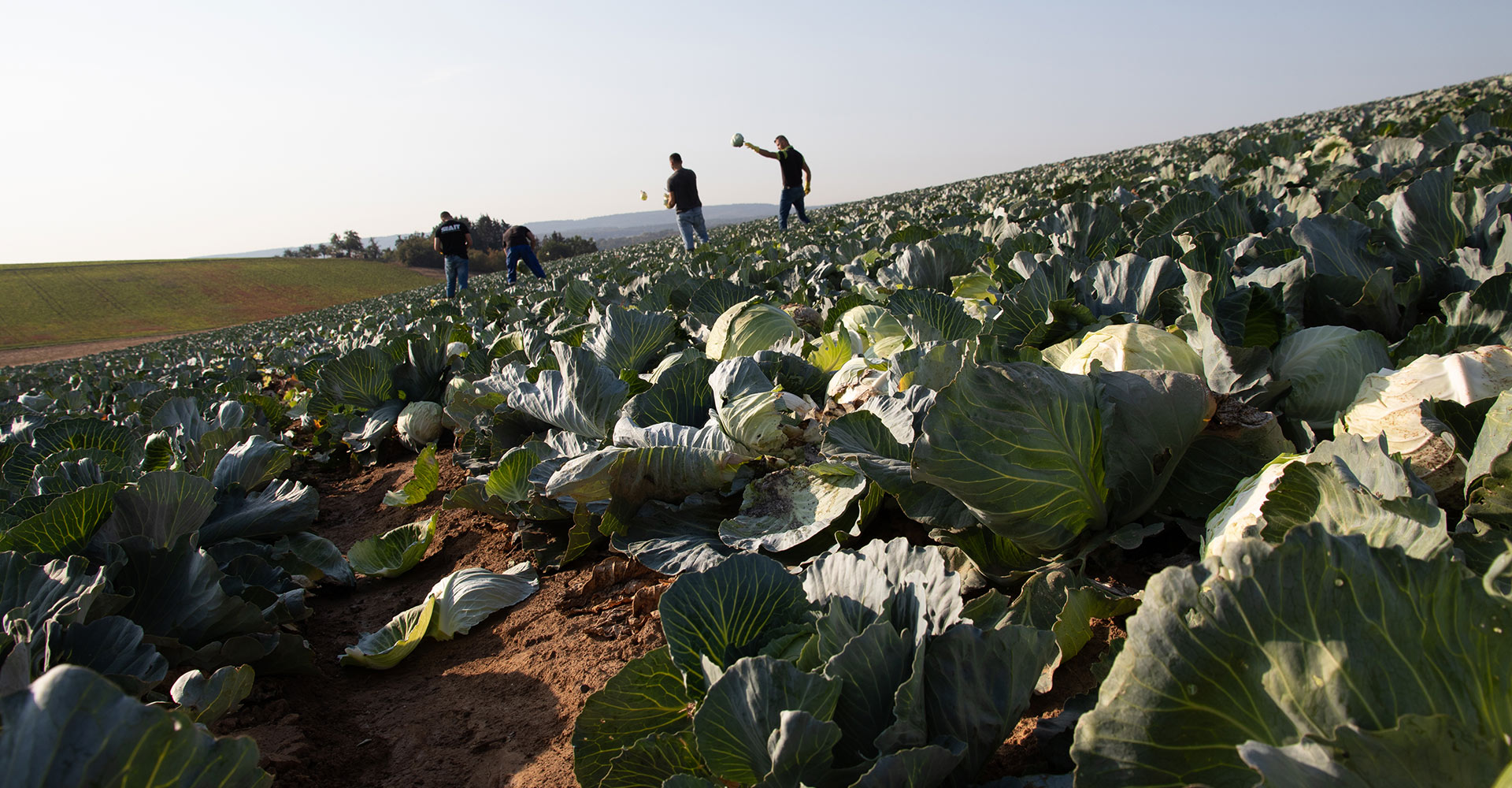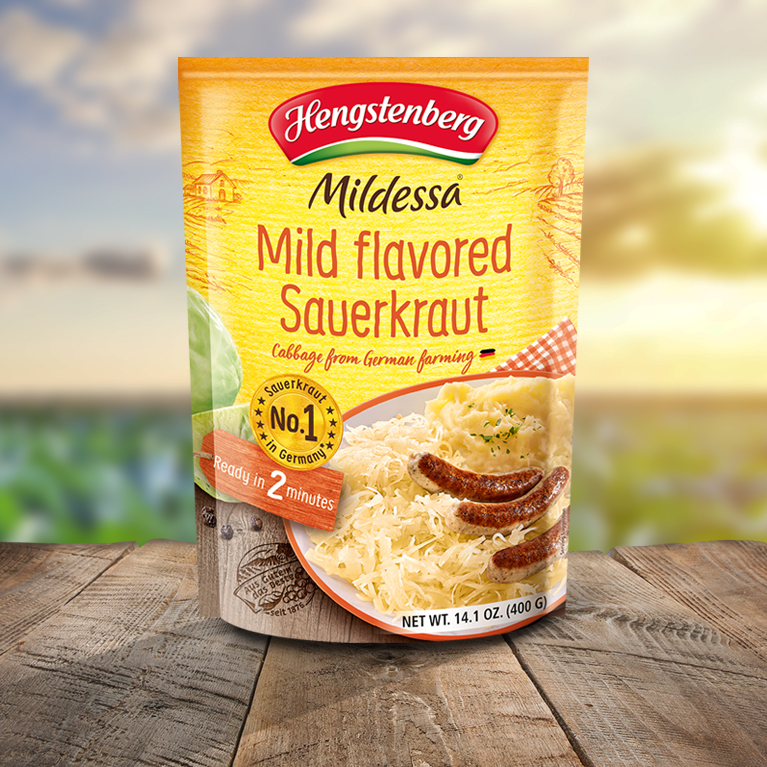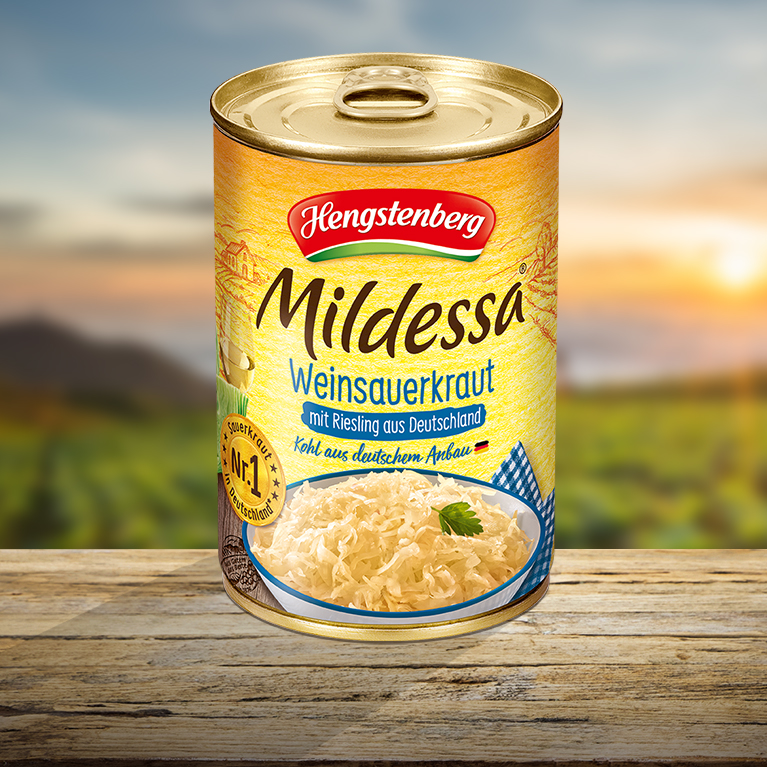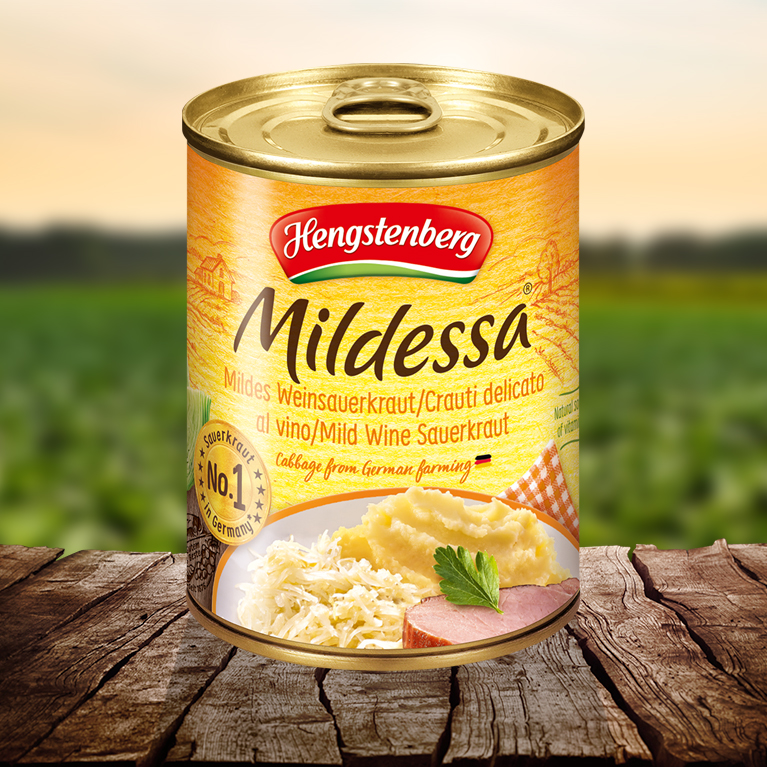Our packaging says: "Cabbage from German cultivation". That's what we stand for. On this page, we'll tell you why we place so much value on it - and follow the journey our cabbage takes during sauerkraut production: from the cultivation of the cabbage in the field to your plate at home. Follow us!
Sauerkraut production:
From the field to your plate
We show you how and where good white cabbage becomes our best Mildessa sauerkraut.

For many generations, Hengstenberg has been producing the finest sauerkraut from sustainable cultivation in Germany. You think that's good? So do we. Even better is that we pay great attention to the high quality of our raw materials. That's why we work closely and trustfully with our farmers - for many decades and for several generations. We have been processing cabbage for over 60 years with a lot of experience and exclusively according to our family recipes. This gives our specialties the mild taste to which they owe their name Mildessa (which comes from the two German words „mildes Sauerkraut“ which means mild sauerkraut) and which we guarantee with every product.

The cultivation of sauerkraut: From fields nearby
Sauerkraut production begins in the field: From March to May, our contract farmers sow the white cabbage in their fields around our production sites. And because many farmers have been growing white cabbage for generations, they are true professionals with whom we are happy to work. They know the different cabbage varieties and what a cabbage needs for optimum growth and high quality. This is how farmers supply our factories with high-quality white cabbage.
"Our raw material purchasing team regularly exchanges information with the farmers. This allows us to identify and overcome challenges early on. This is particularly important in hot summers or times of drought."
Local cultivation is a priority for us: most farmers operate their farms within a radius of about 25 km around our factories. In short: the home of our farmers is also the home of Hengstenberg.
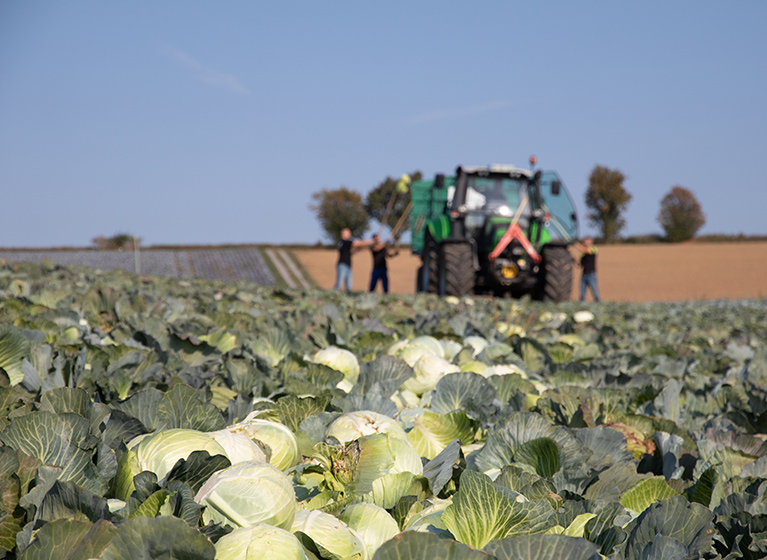
The white cabbage harvest: By hand and by machine
Autumn is harvest time for the fully grown white cabbage, which later becomes our sauerkraut. Many of our farmers harvest the white cabbage by hand. This is done in two steps: In step 1, they cut off the cabbages just below the stalks with a large knife and lay them in long lanes on the fields. In step 2, a tractor slowly drives down the lanes and the harvesters use forks to heave the cabbages onto the trailer. It's sweaty work. After all, a cabbage head weighs 3-4 kilograms.
The harvest workers already check the cabbage at this point for visible defects. Thus, in the best case, some leaves of the cabbage remain right in the field. In production, we would sort them out anyway. But this way the cabbage leaves are a natural fertilizer for the next generation of white cabbage in the coming season.

Fresh to the factory: short transport routes
Tractors bring our cabbage from the field to our factories. That's only a few kilometers - usually less than 25. We take great care to ensure that the field and the production are close together so that the white cabbage for sauerkraut production reaches us fresh. Before unloading, we weigh the cabage delivery, and when the tractor leaves, we weigh it again. In this way, we determine the tare weight and the amount of cabbage.
Upon arrival at the plant, we always take random samples and check for rot or other cabbage diseases. You’re wondering how we do that? It's simple: we use a large knife to cut the cabbages in half and look at the inside. We pay particular attention to the stalk: this tends to have a woody taste and should not end up in our products. Therefore, we check how far the stalk protrudes into the cabbage heads so that we can adjust the stalk drill optimally. Continue reading to find out more about the preparation.

Unloading: Rolling towards production
We do not unload the white cabbage by hand. For this process, we take a different approach: We have height-adjustable ramps. The tractor and its trailers "dock" there, the ramp is adjusted to the height of the trailers and the trailer is tilted. As a result, the cabbages roll off the trailer onto conveyor belts towards production.
There is a special feature at our plant in Fritzlar, the largest sauerkraut factory in Europe: With a gigantic ramp, we can tilt the entire carriage. This means that even non-tilting trailers can unload quickly and control exactly how steeply the cabbages roll.

Preparation for production:
Visual inspection, remove outer leaves and drill out stalks
After unloading, the cabbage arrives in the production hall on conveyor belts. Spirals remove the loose leaves that may still be attached to the cabbages. Each cabbage head is checked by our staff and cut again if necessary, until all the outer leaves have really been removed. We give them to our farmers so they can use them as fertilizer for their fields. Next, drills remove the stalks from the cabbages.
„The woody stalk must be removed. We don't want to cut away any good cabbage in the process."
Important: We do not wash the cabbage! The leaves contain valuable lactic acid bacteria, which later play a crucial role for the fermentation!

Slicing: Cut the cabbage into fine strips
The leaves are gone, and so is the stalk. Now the cabbage is sliced - and not too thinly. A large slicer - made of rotating discs with grooves - planes the cabbage into fine strips. This is how we get the typical sauerkraut strings which benefit our Mildessa sauerkraut. These help the fermentation process, as the sugar that is naturally contained in the cabbage is released easily through the fine cut.
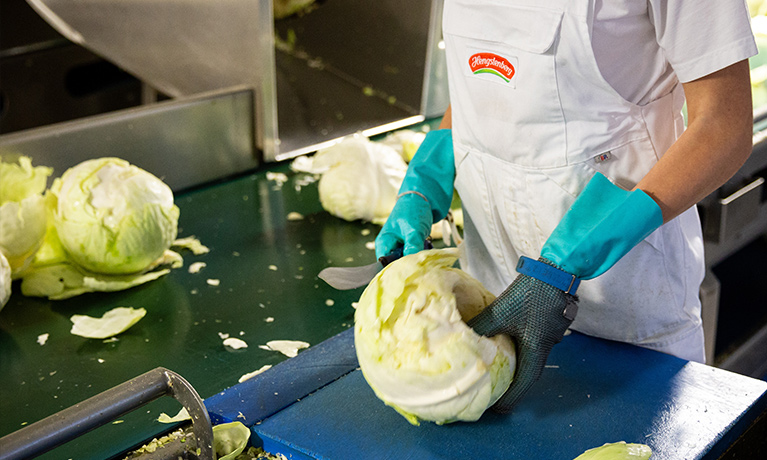

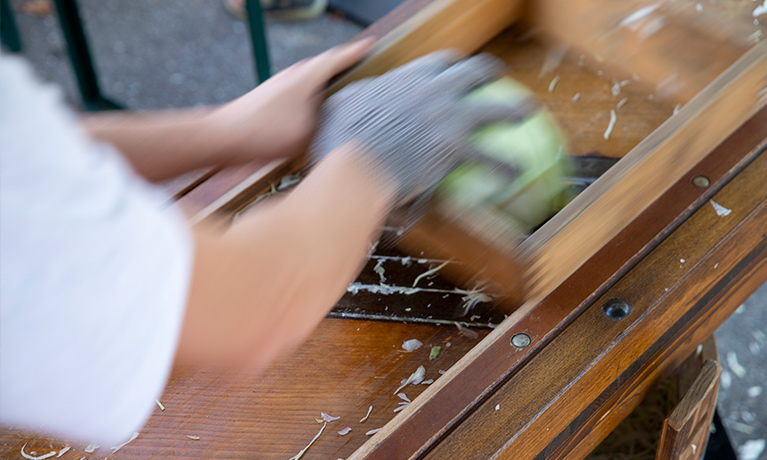
In the past, the sauerkraut was still sliced by hand. Such a slicer is still in our archives today and is occasionally used at events. The historic slicer is a "bench" containing a large grater over which the cabbage is pulled. At the bottom, the fine strings of cabbage fall into a large wooden bowl or bucket.

Salting and way of storage: the pressure rises
The sliced cabbage moves on a conveyor belt toward the fermentation tanks and gets covered with salt. Once the white cabbage arrived in the fermentation containers, a very important step for sauerkraut production starts: A large cushion, filled with water, is placed on top of the cabbage. This compresses and seals it airtight so that fermentation can begin.

The fermentation: slowly it becomes sauerkraut

The cabbage spends around seven days in the fermentation tanks under the pressure of the water cushions. The lactic acid bacteria do the work here and convert the sugar of cabbage into lactic acid. This natural fermentation turns the white cabbage sour, resulting in Sauerkraut – with the unique mild flavour.
To ensure that everything really runs smoothly in terms of taste, we check the acidity of the cabbage at regular intervals. When it has the right degree of acidity we proceed with the next production steps.

Removal and filling: ready for packaging

When the cabbage has the perfect acidity, the fermentation was successful. Next, we let the water out of the cushions, remove them and take the Sauerkraut out of the fermentation tanks with large grabs. Now we move on to filling. This is where our tins, jars and pouches come into play. They are cleaned with compressed air before – and finally the sauerkraut goes in. The tins for our Mildessa wine sauerkraut are given a shot of white wine before the cabbage is filled. At the end, tins, pouches and jars are sealed.
On the production line, we print each package of Sauerkraut with a special code. With the code we can trace the product. So, if you ever have something to complain about and give us the code, we know all the details about the production.

Pasteurisation: Preserving in a natural way
The sealed packages continue their way to the pasteuriser to preserve our Mildessa sauerkraut. The pasteuriser is like a big pressure cooker, where hot steam is used to stop the lactic acid bacteria in the sauerkraut from fermenting further. You're wondering at what temperature and for how long we pasteurise our Mildessa sauerkraut? Sorry, we won't tell you - it's a well-kept company secret. But we take this process very seriously. Because pasteurising too hot destroys the valuable vitamin C - and if the pasteurisation is too cool, the products do not have a long enough shelf life.
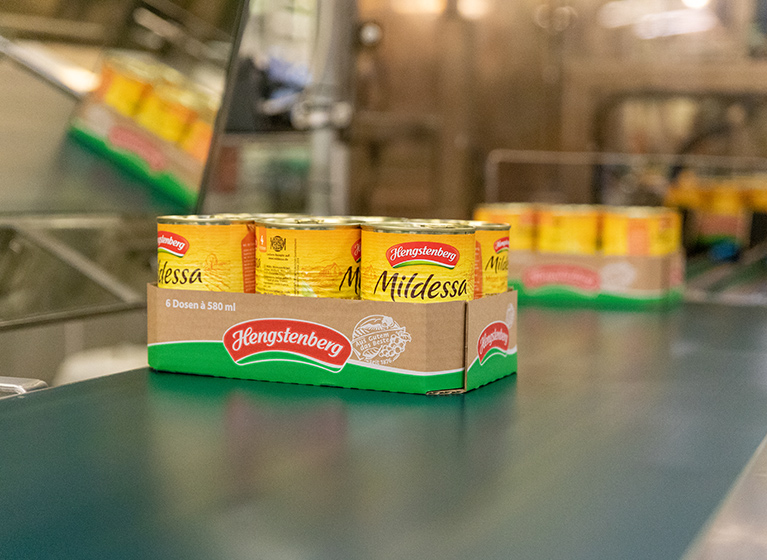
Labelling, packaging and storage: On the way to your plate
We label the freshly pasteurized sauerkraut - so you can recognize it immediately in the supermarket and know what's inside.
We then pack the Mildessa sauerkraut into cartons, stack them on pallets and transport them to our warehouses, where the sauerkraut stays for a while. And finally, we deliver it so that it reaches the plates of our Mildessa fans.
We have shown you the most important steps in sauerkraut production - from the field to your plate: The best white cabbage from German cultivation and our many years of experience in sauerkraut production make Mildessa what it is: Germany's No. 1 in sauerkraut - with the unmistakable taste from Germany. In the recipe section we show you the best ways to enjoy it.

